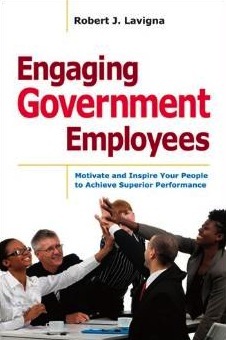Lavigna book shows managers how to engage employees
You could say that Bob Lavigna, UW–Madison’s assistant vice chancellor and director of human resources, wrote the book on public-sector employee engagement. And you’d be right.
Lavigna, who has more than 30 years of experience working with public employees, has authored “Engaging Government Employees,” a book intended to give managers guidance on engagement — the science of motivating and inspiring workers to improve their performance.

“There are many books on the topic of employee engagement, but I hadn’t seen one that focuses on the unique challenges of measuring and improving engagement in public-sector organizations, including public higher education,” Lavigna says.
Governing magazine listed Lavigna’s book as one of five titles that public-sector managers should read in 2014. In April, Lavigna was invited to Dubai to keynote a conference for human resources (HR) professionals in the Middle East. He’s also spoken about the book at other events, including on campus.
The idea for the book came to Lavigna while he was working as vice president for research at the Partnership for Public Service, a nonprofit organization where he was responsible for an employee engagement-based ranking of federal agencies called “Best Places to Work in the Federal Government.”
When he was hired at UW–Madison in 2010, Lavigna was tasked with leading engagement efforts in the Vice Chancellor for Finance and Administration division. In addition, he was given the assignment of overhauling the university’s HR system.
Bob Lavigna
“I knew for HR Design to be successful, we would need to get employees from across the university engaged in the process,” Lavigna says. “As it turned out, their feedback was invaluable as we developed the strategic plan for the new human resources system.”
Former Chancellor David Ward called the HR Design project “perhaps the most extensive effort ever undertaken on our campus to engage in a frank and open discussion about our work environment.” To date, 104 events have been held across the campus to publicize and discuss the new HR system. These events have attracted more than 13,000 attendees — and counting.
Lavigna’s book includes a series of strategies to improve engagement. While he argues that there are no one-size-fits-all solutions to improving employee engagement (i.e., actions should be based on engagement survey results), here are some approaches that Lavigna highlights:
- Regularly measure employee engagement, ideally through a valid employee survey. Surveying allows the organization to collect data about, and therefore understand, the current level of engagement — and where to act to improve it.
- Make sure that leaders, managers and supervisors understand why employee engagement matters and why they should pay attention to it. Research has clearly shown that high levels of engagement translate into improved individual and organizational performance. It’s also critical to hold leaders, managers and supervisors accountable for taking action to improve engagement.
- Adopt good performance-management practices. That is, make sure that all employees understand their roles and goals, receive regular performance feedback, and have opportunities to develop and grow.
- Recognize good performance, even if financial rewards are limited. Sometimes this simply means telling an employee that he or she has done a good job.
- Empower and encourage employees to express their opinions, suggest better ways to operate, and have a real voice in decision-making.



